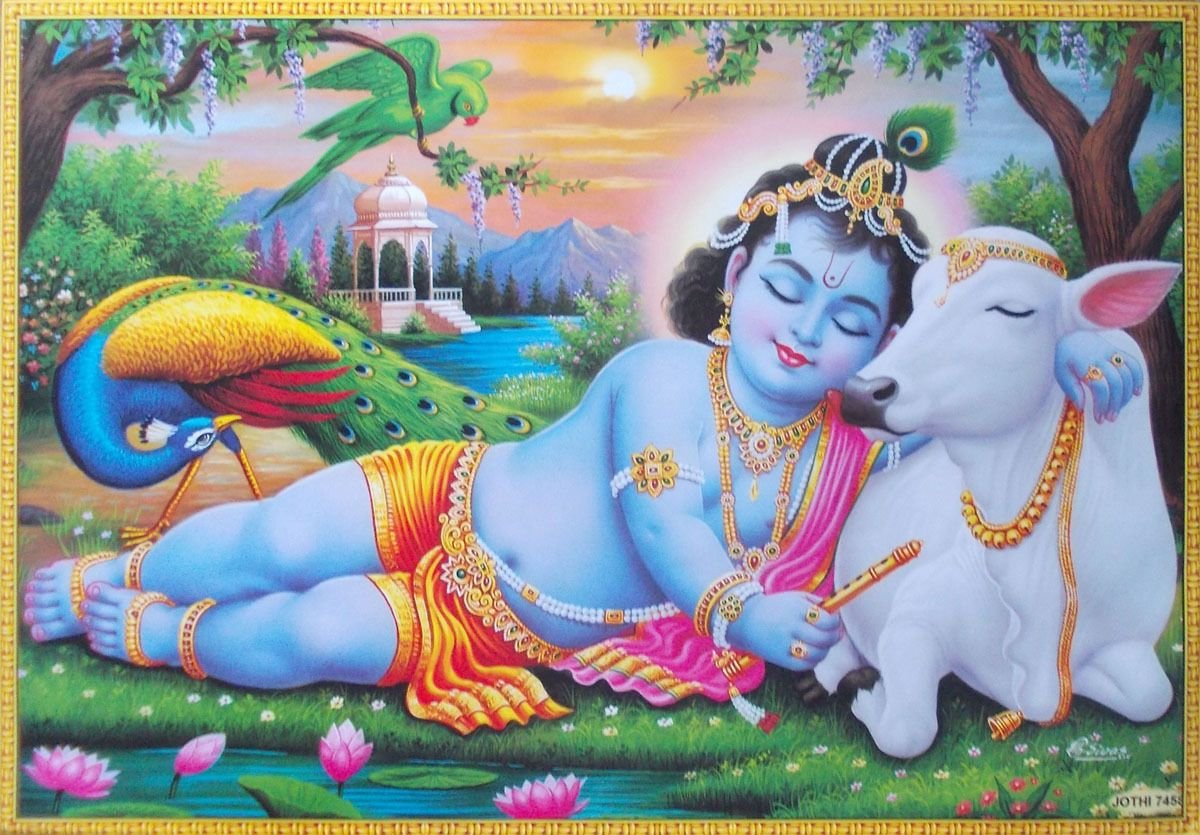
This reminds me of this wonderful shloka by Leelashuka in the Sri Krishna Karnaamrutam
Yadromarandra paripoorthi vidhou adakshaa
Vaaraaha janmani bhabhuvu: amee samudraa: |
Tam naama naatham aravindha drsham Yashoda
Paanidwaya antara jalai: snapayaam bhabhoova ||
Yadromarandra paripoorthi vidhou adakshaa
Vaaraaha janmani bhabhuvu: amee samudraa: |
Tam naama naatham aravindha drsham Yashoda
Paanidwaya antara jalai: snapayaam bhabhoova ||
https://twitter.com/ANI/status/1432408730012901376
When this same Child took the form of Adi Varaaha, waters in all the oceans put together failed to fully drench His hair follicles. But now, Yashoda is able to bathe the Lotus-eyed One with with just two handfuls of water. 



It is interesting that Leelashuka drew a parallel with Varaaha avatar here. Even Adi Shankara in His magnus opus Soundaryalahiri says, Nimadhanam damshtra muraripu Varaahasya bhavati.
Oh Mother, the dust of Your Feet can redeem people from this sea of samsara
Oh Mother, the dust of Your Feet can redeem people from this sea of samsara
just like how Varaaha lifted the Earth on His tusks. Therefore, the allusion to Varaha is not mere coincidence or a matter of poetic convenience. Actually, the naamas Krishna, Govinda et. al. apply first to Varaaha avatar. Krishna avatar is indeed Varaaha redux.
In one my earlier posts on Vaamana charitam, I touched upon the fact that avataras serve to re-establish existing tatva of Paramatma already expounded in the Vedas.
https://twitter.com/SparesofWar/status/1428992133529096192?s=20
Adi Varaaha is the first avatara for this Kalpa. That's why we say the sankalpam as Shweta Varaaha Kalpe, Vaivasta Manvantare and so on. Unlike popular notion, there is no set chronology or evolutionary precedent for avataras.
Vedam refers to Varaha as Krishna. The Yajur Veda says Uddrthaasi Varaahena Krishnena Shatabaahunaa
Oh Bhumi Devi! You were lifted by Krishna with a hundred (aka infinite) arms in the form of Varaha.
Vedas have been existent even before this Kalpa commenced.
Oh Bhumi Devi! You were lifted by Krishna with a hundred (aka infinite) arms in the form of Varaha.
Vedas have been existent even before this Kalpa commenced.
The naama Krishna denotes attraction while also indicating Brahman. The etymology of the name Krishna was told by Krishna Himself in the Udyoga Parva of the Mahabharata.
Krishir bhuvaachako shabdo nascha nirvrutthivaachaka: |
Tayoraikyam Parambrahma Krishna ityabhidheetaye ||
Krishir bhuvaachako shabdo nascha nirvrutthivaachaka: |
Tayoraikyam Parambrahma Krishna ityabhidheetaye ||
The word Krish stems from the dhatu Bhu, which denotes Sat (ever existent) while Na is a nirvrutthi vaachaka i.e. ever lasting bliss, also known as nirvaana or chit-aananda. Combining Krish and na, it becomes clear that Krishna is Satchitaananda or Brahman Itself
This Satchitaananda tatvam is the real Soundaryam, which, unlike material beauty, does not degrade. This could likely be the reason why Adi Shankara brought the reference of Varaaha in the Soundaryalahiri.
This same Bhu sattaayam dhatu quality was exhibited by Varaaha, hence He is Krishna.
Similarly, Varaha is also known as Govinda. The name Govinda comes from Gavaam vindhati iti Govinda: That means One who is known by Go, One who can be reached by Go, and One who protects Go.
Similarly, Varaha is also known as Govinda. The name Govinda comes from Gavaam vindhati iti Govinda: That means One who is known by Go, One who can be reached by Go, and One who protects Go.
Go, in Vedic parlance, can mean Bhumi, Govansh, devotees, Vedas, etc. Vedam says Gobhi: rasmibhi: even the rays of the Sun are Go. When we worship the Sun or do Sandhyavandanam, we are in fact paying obeisance to Govinda who is the main source of effulgence.
Shankaracharya in the Govindaashtakam says,
Gobhirnigadita Govindasputha naamanam bahunaamanam
One who lifted the Govardhan Hill, One whose name of Govinda is uttered clearly by cows (and all other applicable derivatives of Go including Vedas).
Gobhirnigadita Govindasputha naamanam bahunaamanam
One who lifted the Govardhan Hill, One whose name of Govinda is uttered clearly by cows (and all other applicable derivatives of Go including Vedas).
Since Bhumi is also known as Go, the One who lifted the earth is Govinda. That's why Vishnu Sahasranamam says Maha Varaaho Govindo susheno kanakaangadhi. In fact, Tirumala is known as Adi Varaha kshetra in all Puranas. The Srinivasa Gadhyam says,
Nikhila suraasura vandhita varaaha kshetra vibhushanasya. One Who resides in the Varaaha Kshetra adored by Devas and Asuras. When we climb the Hills in earnest seeking remedy to the malefics in Kali Yuga, we primarily chant Govinda namas than any other name.
In Southern traditions, Varaha is also known as Gnaanappiraan. The same gnaana was also given by Krishna many a time at appropriate occasions of which the Bhagavad Gita prominently stands out.
May Bhagavan shower His choicest of blessings on Bharata Bhumi and its people 🙏🏻
May Bhagavan shower His choicest of blessings on Bharata Bhumi and its people 🙏🏻
• • •
Missing some Tweet in this thread? You can try to
force a refresh





